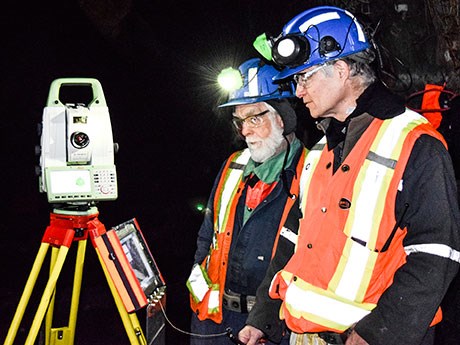Northern Survey Supply launches new, improved MOSS
The Miner Operated Survey System (MOSS) developed by former Falconbridge employee Bernie Smith and still in use by Glencore at its Nickel Rim and Raglan operations, is finally being made available to the global mining market.
Northern Survey Supply (NSS), a surveying company serving the mining industry from offices in Sudbury and Oakville, teamed up with the now retired Smith, who has rewritten MOSS in an AutoCAD platform, making it “far superior in operating power and functionality,” according to NSS senior account manager Bruno Lalonde.
Miners perform the survey and overlay it on the mine plan using a tablet, “so they can understand in real time every round, every face and how it has broken.”
The system calculates overbreak and underbreak, “which is great, unheard of and doesn’t happen anywhere else,” said Lalonde.
“Studies show that most mines are looking at an overbreak of 20 per cent. With MOSS, we’re able to bring that down to under 10 per cent, so there’s less waste and an immediate return on investment.”
The system tells the miner exactly where to collar the hole within millimetres of accuracy. The miner puts paint marks on the face and marks up the whole pattern. Using the traditional method of marking up the face takes a lot more time, and is much less accurate.
“Also, with this process there’s no need for a scoop at the face to mark it up because you can use a paint stick to reach the back height without any problems,” said Lalonde.
Using an instrument called the MS60, which is integrated with the MOSS system, the miner does a full 3D LiDAR scan.
“It takes a picture and creates a point cloud which then creates a 3D mesh. With this process, you’re able to get an accurate volume.
“With 3D mapping, geologists can see any slips, dykes or structure issues in the back. If the miner is at the face and says the ground doesn’t look too good, he can connect to the network and the geologist on surface can see what’s going on, per face, per round. As the development is going forward, so is this information.”
The imagery also shows the ground support, so in the event of a fall of ground, there’s documentation to prove that the ground support was properly installed.
MOSS positively impacts professionalism and worker satisfaction, said Lalonde.
“Because the surveys are done per round, per shift, the guys take a lot more ownership of their work. There’s more pride involved. At the end of a shift, they can say ‘I was under five per cent overbreak.’ Because they take a picture, they know what the round looks like.”
Because of the improved accuracy, miners aren’t blaming the cross-shift for deviations from the mine plan, resulting in greater harmony in the workplace.
MOSS pays for itself in short order.
“The return on investment is within 82 metres of development,” said Lalonde. “The cost savings are huge. We’re not talking thousands. We’re talking millions.”
There is also an improvement in cycle times.
“The whole process – markup, setting up the instrument, teardown – takes 25 minutes, which is huge because the normal cycle time to mark up a face is an hour plus, so we’re saving on cycle time and saving on surveyors and geologists not having to come down to the face.”
In the absence of MOSS, surveys aren’t done as frequently, so there’s a possibility of significant deviation from the mine plan.
“Traditionally what happens is you get out by four feet, you get out by a metre and the mine design has to be adapted based on that because you can’t just say, ‘We’ll turn here.’ You can’t do that in rock. MOSS helps miners stay true to the mine plan.
“It’s easy for me to believe in the system because of my surveying background,” said Lalonde. “I never had MOSS. Now that I see MOSS and how simple it is to implement, I’m convinced it’s the way surveying is going.”
Lalonde is confident that miners will embrace the change. Training takes one day, and for today’s technologically savvy younger miners, it’s easy to learn and a welcome addition to their routine.
Surveyors still have to go down and do quality control every 100 or 200 metres, but MOSS frees them up to do other things and eliminates the dreaded month-end calculation of volumes.
“Traditionally at month end, surveyors have to go down to every single heading,” said Lalonde. “It’s crazy at the end of the month. Every surveyor hates it. With MOSS, they no longer have to do that because it’s done every day, every shift.”
The new improved version of MOSS was launched at the PDAC in March and is being marketed by Northern Survey Supply to the global mining market.



